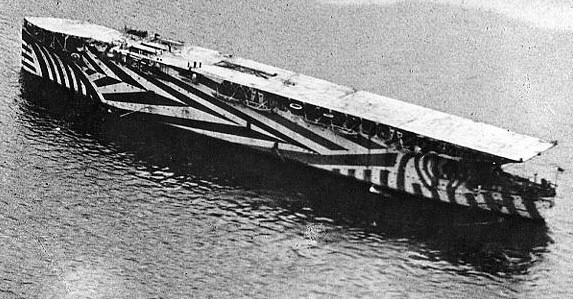Razzle Dazzle
If you look up the term “camouflage,” you’ll almost certainly find a definition dealing with the idea of “concealment” or the term “hide.” (Just ask Merriam-Webster.) But the goal of camouflage, taken broadly, isn’t necessarily either of those two things. If a person, airplane, or in the case below, ship, can avoid harm by visually shouting out its presence, that would work just as well. Pulling that off it no easy task, of course — it’s much more straightforward to sneak past the enemy’s defenses than to dance in front of them and hope they miss — but that hasn’t stopped military strategists from trying.
They even called it Razzle Dazzle.
“Razzle dazzle,” to ask Merriam-Webster again, is “a complex maneuver designed to confuse an opponent” and “a[n] often gaudy action or display.” Confusion — gaudy or not — can be just as effective as concealment, and that was what the British and American naval leadership were counting on in World War I and into World War II, as seen above. Traditional camouflage proved unworkable, because as the weather changed, the color and shape of the ships’ paint jobs would have to change as well, and that’s simply not possible to do while at sea. Starting from a blank slate, the British admiralty (we think — who originated the idea is disputed, with even Picasso once laying claim to it) came up with zebra stripes.
At the time, lookouts would use telescope-like devices called “coincidence rangefinders.” As Wikipedia explains, these rangefinders combined two images of the target into one. if the images matched, they’d appear clearly, and the technician operating the rangefinder could take a reading from the device, estimating the ship’s distance. Plot a few such points against a pre-established time increment and you could determine the ship’s speed and size as well. But what if the images never seemed to line up? The naval strategists behind the razzle dazzle designs believed that the chaotic patterns would make it difficult for the opposing side to determine how far away the ships were, thereby obfuscating their speed and size, too. And, as a bonus, each ship had its own unique pattern, making it impossible for the enemy to determine which convoy an individual ship was part of.
Or at least, that was the theory. Whether it worked is unknown, because there were too many variables to test. Stripes varied in number, color, locations, and width; add in the conditions of war (including, again, the weather) and it is nearly impossible to determine which factors mattered and which were superfluous (or even detrimental). By the end of World War II, razzle dazzle camouflage fell into disuse.
Bonus fact: Zebras are black with white stripes, not the other way around. That is, their underlying body color is black — although they’re always striped, so practically speaking, this is of little consequence.
From the Archives: The Phantom Menace: Another wartime art project.
Related: Zig-zag zebra tape, which could be used for decorating a boat, in theory.

